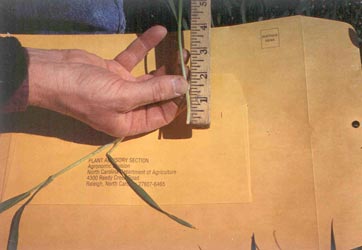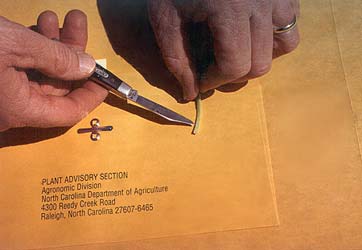Wheat Tissue Sampling
go.ncsu.edu/readext?764646
en Español / em Português
El inglés es el idioma de control de esta página. En la medida en que haya algún conflicto entre la traducción al inglés y la traducción, el inglés prevalece.
Al hacer clic en el enlace de traducción se activa un servicio de traducción gratuito para convertir la página al español. Al igual que con cualquier traducción por Internet, la conversión no es sensible al contexto y puede que no traduzca el texto en su significado original. NC State Extension no garantiza la exactitud del texto traducido. Por favor, tenga en cuenta que algunas aplicaciones y/o servicios pueden no funcionar como se espera cuando se traducen.
Português
Inglês é o idioma de controle desta página. Na medida que haja algum conflito entre o texto original em Inglês e a tradução, o Inglês prevalece.
Ao clicar no link de tradução, um serviço gratuito de tradução será ativado para converter a página para o Português. Como em qualquer tradução pela internet, a conversão não é sensivel ao contexto e pode não ocorrer a tradução para o significado orginal. O serviço de Extensão da Carolina do Norte (NC State Extension) não garante a exatidão do texto traduzido. Por favor, observe que algumas funções ou serviços podem não funcionar como esperado após a tradução.
English
English is the controlling language of this page. To the extent there is any conflict between the English text and the translation, English controls.
Clicking on the translation link activates a free translation service to convert the page to Spanish. As with any Internet translation, the conversion is not context-sensitive and may not translate the text to its original meaning. NC State Extension does not guarantee the accuracy of the translated text. Please note that some applications and/or services may not function as expected when translated.
Collapse ▲Happy New Year! With the New Year beginning, the dormancy stage of wheat will soon end, which means it is nearing time for tissue sampling.

At Zadoks GS 30 (Feekes GS 5), the growing point will be1/2 inch above the crown. At this stage of growth, the stem has begun to elongate and leaf sheathes are erect.
If you are tissue sampling wheat, to send to the North Carolina Department of Agriculture and Consumer Services, timing is everything. The analysis done by the NCDA&CS is made specifically for wheat at Zadoks GS30 (Feekes PS 5). So before you take samples this year check and make sure your wheat is at the right group stage before you take samples so your nutrient recommendation is as accurate as possible. To do this, go into your field and pull a few plants, from multiple areas in your field.
Take a plant and carefully split the stem with a knife starting at the crown to locate the growing Point inside. This growing point will look like a tiny green pinecone. If they’re growing point is a half an inch above the crown then your wheat is at Zadoks GS30 (Feekes PS 5) and is at the appropriate time to take tissue samples. Do this for multiple areas in your field to make sure all of the field is at the same growth stage.

The growing point at Zadoks GS 30 (Feekes GS 5) looks
like a tiny green pine cone and is 1/2 inch above the
crown.
If you have any questions or need more information about wheat tissue sampling please contact me at 704-441-2624 or mgraham4@ncsu.edu.
Illustrations are from NCDA&CS.





